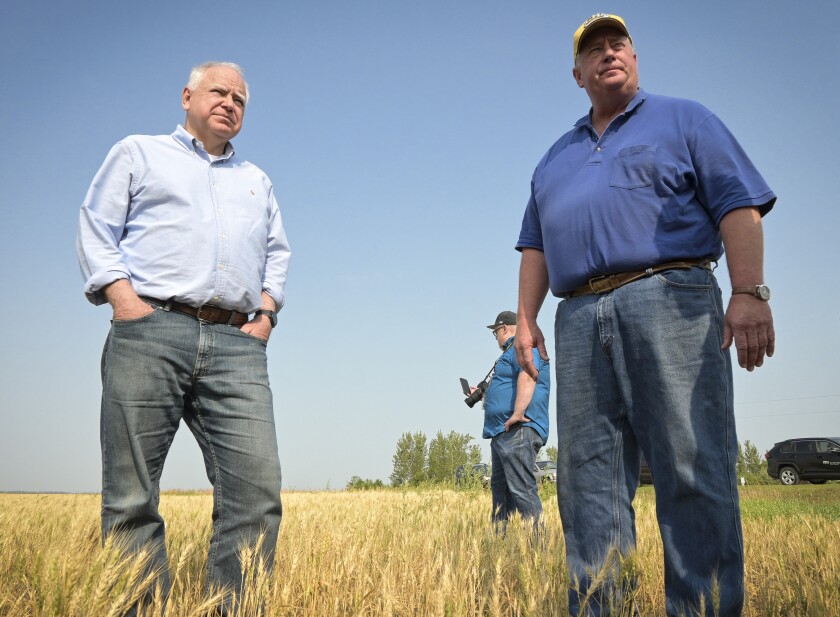CROOKSTON, Minn. — Less than two years after Minnesota Gov. Tim Walz was in Polk County to hear from farmers whose crops were damaged by excessive rains, on Thursday, July 22, he returned to listen to their concerns about the drought that is increasingly becoming more severe.
About 35 farmers, including members of commodity and agricultural organizations and the Minnesota Legislature, gathered at Jim Reitmeier’s farm northwest of Crookston on July 22 to talk to Walz about the harm the dry conditions have caused their grain and row crops. Meanwhile, the damage the drought is wreaking on livestock producers’ farms and ranches is even worse, farmers said.
According to the U.S. Drought Monitor update released Thursday, about 80% of Minnesota is in a moderate drought and about 20 counties have at least parts of them in a severe drought.

ADVERTISEMENT
Drought is more insidious and less visible than hail or flood damage so it’s sometimes difficult for people who don’t live on farms to understand what a serious issue it is for farmers and the financial loss it causes, Walz said.
“We wanted to get out here today so we can tell the rest of the state,” Walz said.
The dry conditions already have reduced his wheat yields, said Reitmeier. His wheat fields like others across northwest Minnesota and North Dakota were pushed to maturity by hot, dry conditions, which hurt yield potential.
“The row crops still have a chance if we get moisture. Everything is going to hinge on that,” he said.
Dry edible bean fields also have suffered from the drought, said Eric Samuelson, Northarvest Bean Growers Association president and a Crookston farmer.
“I think there's going to be a lot of reduced production,” he said.
The financial effect of the crops’ loss will be felt on Main Street, Samuelson said.
“It’s going to trickle down,” he said.
ADVERTISEMENT
While crop production has been hurt by the drought, its effect on livestock producers is even more serious, farmers at the meeting told Walz.
Cattle producers have been particularly hit hard by the drought because the dry conditions have damaged pastures and forage. Minnesota farmers, like North Dakota farmers are selling cattle because they don’t have enough feed.
The drought drastically reduced the hay production of Neil Peterson, a Pennington County Commissioner from St. Hilaire. His first cutting of hay typically yields from 700 to 800 large, round bales, and this year it yielded only 100. Peterson won’t get a second cutting this year because it’s so dry, he said.
Bagley Livestock Auction Inc., which usually doesn’t sell cattle during the summer, is auctioning several hundreds of cattle weekly, Peterson said. Replacing those cattle will be difficult for farmers and ranchers.
“The livestock producers, you spend a whole lifetime rebuilding those herds,” Peterson said.

Walz has asked U.S. Agriculture Secretary Tom Vilsack to open up Conservation Reserve Program land in Minnesota counties hard hit by the drought, he said. Meanwhile, the Minnesota Department of Agriculture talked to the Nature Conservancy about opening up some of its land for haying and grazing, said Thom Peterson, Minnesota Department of Agriculture Commissioner.
ADVERTISEMENT
“One thing this office can do is advocate on a political level,” Walz told farmers. For example, for the last few months, he has been meeting with Vilsack and apprising him of the escalating drought and its effect on farmers and ranchers.
“There are a lot of hoops to jump through, and we’ve got to jump through them,” Walz said.








